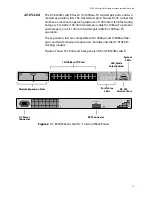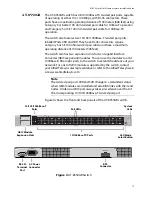
Overview
24
A port on the switch connected to a powered device can supply up to
15.4 watts of power to the device, while at the same time furnishing
standard 10/100 Mbps Ethernet functionality. A port connected to a
network node that is not a powered device (that is, a device that receives
its power from another power source) functions as a regular Ethernet
port, without PoE. The PoE feature remains enabled on the port but no
power is delivered to the device.
AT-8524POE’s
Implementation
of PoE
A standard Ethernet twisted pair cable contains four pairs of strands for a
total of eight strands. 10/100 Mbps network traffic requires only four
strands, leaving four strands in the cable unused. The strands that carry
the network traffic are 1, 2, 3, and 6, and the spare strands are 4, 5, 7, and
8.
The IEEE 802.3af standard, which is the standard for PoE, describes two
methods for implementing PoE over twisted pair cabling. One method
uses the same strands that carry the network traffic and the other the
spare strands.
The PoE implementation on the AT-8524POE switch transmits power
over the same strands that carry the network traffic. The power transfer
does not interfere with the network traffic. The power and the network
traffic can coexist on the same strands simultaneously.
Powered devices that comply with the IEEE 802.3af standard typically
support both methods of power delivery methods. So you should not
need to concern yourself about whether a powered device is compatible
with the switch’s power delivery method. So long as a powered device is
compliant with the standard, it should be able to receive its power from
the switch.
The PoE feature on the switch should also work with most legacy
powered devices as well. A legacy device is a node that was
manufactured before the IEEE 802.3af standard was completed and,
consequently, may not adhere to the standard.
Power
Budgeting
The AT-8524POE switch can provide up to a total of 400 watts (W) of PoE
power and a maximum of 15.4 W per port on Ports 1 to 24. (PoE is not
supported on expansion modules.) In the default configuration, the
switch can provide the maximum of 15.4 W on all 24 ports for a total
power requirement of 370 W, which is below the maximum available.
The fact that the maximum possible power requirement falls below the
maximum amount of power available means that you can connect
powered devices to all the ports on the switch (excluding optional
expansion ports) without having to be concerned about exceeding the
available power, even if the all the powered devices require the
maximum of 15.4 W.
















































